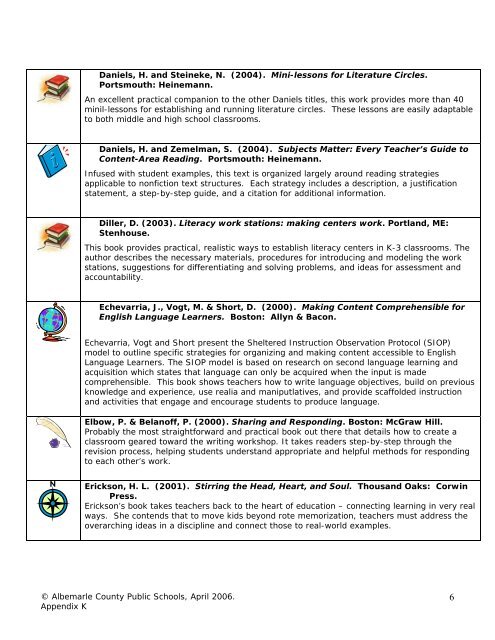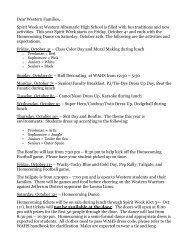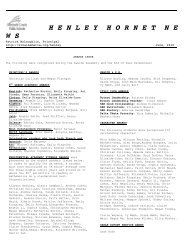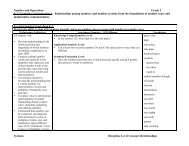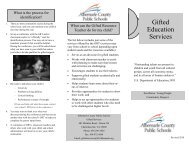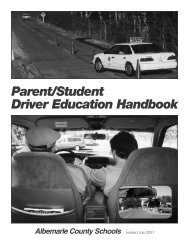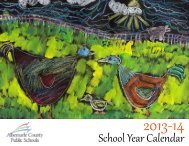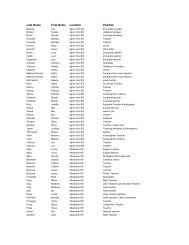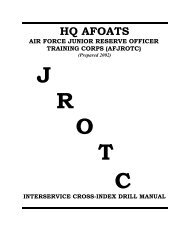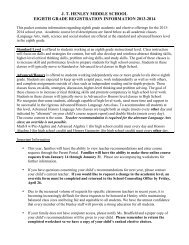Language Arts/English Curriculum Frameworks - Albemarle County ...
Language Arts/English Curriculum Frameworks - Albemarle County ...
Language Arts/English Curriculum Frameworks - Albemarle County ...
Create successful ePaper yourself
Turn your PDF publications into a flip-book with our unique Google optimized e-Paper software.
Daniels, H. and Steineke, N. (2004). Mini-lessons for Literature Circles.<br />
Portsmouth: Heinemann.<br />
An excellent practical companion to the other Daniels titles, this work provides more than 40<br />
minil-lessons for establishing and running literature circles. These lessons are easily adaptable<br />
to both middle and high school classrooms.<br />
Daniels, H. and Zemelman, S. (2004). Subjects Matter: Every Teacher’s Guide to<br />
Content-Area Reading. Portsmouth: Heinemann.<br />
Infused with student examples, this text is organized largely around reading strategies<br />
applicable to nonfiction text structures. Each strategy includes a description, a justification<br />
statement, a step-by-step guide, and a citation for additional information.<br />
Diller, D. (2003). Literacy work stations: making centers work. Portland, ME:<br />
Stenhouse.<br />
This book provides practical, realistic ways to establish literacy centers in K-3 classrooms. The<br />
author describes the necessary materials, procedures for introducing and modeling the work<br />
stations, suggestions for differentiating and solving problems, and ideas for assessment and<br />
accountability.<br />
Echevarria, J., Vogt, M. & Short, D. (2000). Making Content Comprehensible for<br />
<strong>English</strong> <strong>Language</strong> Learners. Boston: Allyn & Bacon.<br />
Echevarria, Vogt and Short present the Sheltered Instruction Observation Protocol (SIOP)<br />
model to outline specific strategies for organizing and making content accessible to <strong>English</strong><br />
<strong>Language</strong> Learners. The SIOP model is based on research on second language learning and<br />
acquisition which states that language can only be acquired when the input is made<br />
comprehensible. This book shows teachers how to write language objectives, build on previous<br />
knowledge and experience, use realia and maniputlatives, and provide scaffolded instruction<br />
and activities that engage and encourage students to produce language.<br />
Elbow, P. & Belanoff, P. (2000). Sharing and Responding. Boston: McGraw Hill.<br />
Probably the most straightforward and practical book out there that details how to create a<br />
classroom geared toward the writing workshop. It takes readers step-by-step through the<br />
revision process, helping students understand appropriate and helpful methods for responding<br />
to each other’s work.<br />
Erickson, H. L. (2001). Stirring the Head, Heart, and Soul. Thousand Oaks: Corwin<br />
Press.<br />
Erickson’s book takes teachers back to the heart of education – connecting learning in very real<br />
ways. She contends that to move kids beyond rote memorization, teachers must address the<br />
overarching ideas in a discipline and connect those to real-world examples.<br />
© <strong>Albemarle</strong> <strong>County</strong> Public Schools, April 2006.<br />
Appendix K<br />
6


